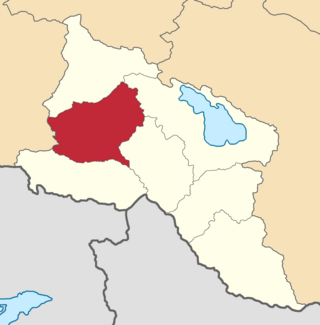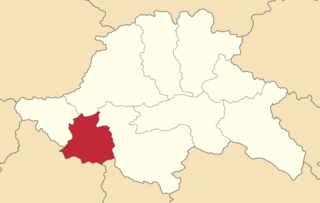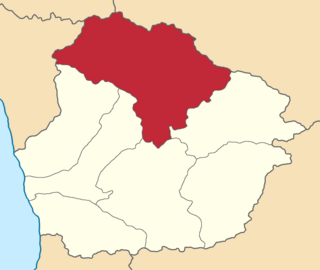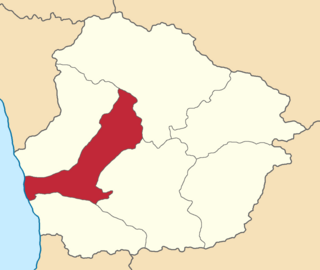
The Borchaly uezd was a county (uezd) of the Tiflis Governorate of the Caucasus Viceroyalty of the Russian Empire, and later of the independent and Soviet republics of Georgia. Its administrative center was the town of Shulavery. The area of the county roughly corresponded to the contemporary Lori Province of Armenia and the Kvemo Kartli region of Georgia.

The Kutaisi or Kutais Governorate was a province (guberniya) of the Caucasus Viceroyalty of the Russian Empire. It roughly corresponded to most of western Georgia throughout most of its existence, and most of the Artvin Province of Turkey between 1878 and 1903. Created out of part of the former Georgia-Imeretia Governorate in 1846, the governorate also included Akhaltsikhe uezd before its cession to the Tiflis Governorate in 1867. The Kutaisi Governorate bordered the Sukhumi Okrug to the northwest, the Kuban Oblast to the north, the Terek Oblast to the northeast, the Tiflis Governorate to the southeast, the Batum Oblast to the southwest, and the Black Sea to the west. The governorate was eponymously named for its administrative center, Kutais.

The Zakatal okrug was a special administrative district (okrug) of the Caucasus Viceroyalty of the Russian Empire, part of the Tiflis Governorate from 1893 to 1905. The administrative centre of the district was Zakataly, and it corresponded to most of the contemporary districts of Balakan, Zaqatala and Qax of Azerbaijan. The Zakatal okrug was established from the territories of the erstwhile Free Jamaats of Jar-Balakan, bordering the Tiflis Governorate to the west, the Elizavetpol Governorate to the south and the Dagestan Oblast to the north. The district was the smallest independent administrative unit of the Russian Empire, similarly to the Sukhumi okrug.

The Surmalu uezd was a county (uezd) of the Erivan Governorate of the Caucasus Viceroyalty of the Russian Empire. It bordered the governorate's Etchmiadzin and Erivan uezds to the north, the Kars Oblast to the west, Persia to the east, and the Ottoman Empire to the south. The district made up most of the Iğdır Province of present-day Turkey. As part of the Russian Transcaucasus, the Surmalu uezd possessed economical importance for its abundantly rich salt mines in Kulp (Tuzluca), and spiritual importance to Armenians as the location of the culturally significant Mount Ararat. The administrative centre of the county was Igdyr.

The Etchmiadzin uezd was a county (uezd) of the Erivan Governorate of the Caucasus Viceroyalty of the Russian Empire. The uezd bordered the Alexandropol uezd to the north, the Nor Bayazet uezd to the east, Erivan uezd to the north, the Surmalu uezd to the south, and the Kars Oblast to the west. It included all of the Armavir Province and most of the Aragatsotn Province of present-day Armenia. The administrative centre of the county was Vagorshapat (Vagharshapat), also referred to as Etchmiadzin—the administrative capital of the Armenian Apostolic Church.

The Ozurgeti uezd was a county (uezd) of the Kutaisi Governorate of the Caucasus Viceroyalty of the Russian Empire. It bordered the Senaki uezd to the north, the Kutaisi uezd to the east, the Akhaltsikhe uezd of the Tiflis Governorate to the southeast, the Batum Okrug of the Batum Oblast to the south, and the Black Sea to the west. The area of the Ozurgeti uezd corresponded to most of the contemporary Guria region of Georgia. The county was eponymously named for its administrative center, Ozurgeti.

The Zugdidi uezd was a county (uezd) of the Kutaisi Governorate of the Caucasus Viceroyalty of the Russian Empire. It bordered the Sukhumi Okrug to the north, the Lechkhumi uezd to the east, the Senaki uezd to the south, and the Black Sea to the west. The area of the Zugdidi uezd corresponded to most of the contemporary Samegrelo-Zemo Svaneti region of Georgia. The county was eponymously named for its administrative center, Zugdidi.

The Shemakha uezd was a county (uezd) within the Baku Governorate of the Russian Empire, and then of Azerbaijan Democratic Republic and Azerbaijan SSR until its formal abolishment in 1929. The county was located in the central part of the Baku Governorate, bordering the Javad uezd to the south, Baku uezd to the east, Geokchay uezd to the west and Kuba uezd to the north. The administrative centre of the county was the city of Shemakha.

The Akhalkalaki uezd was a county (uezd) of the Tiflis Governorate of the Caucasus Viceroyalty of the Russian Empire, and then of Democratic Republic of Georgia, with its administrative centre in Akhalkalak. The county bordered the Gori uezd to the north, the Borchaly uezd to the east, the Alexandropol uezd of the Erivan Governorate and the Kars and Ardahan okrugs of the Kars Oblast to the south, and the Akhaltsikhe uezd to the west. The area of the county corresponded to part of the contemporary Samtskhe–Javakheti region of Georgia.

The Gori uezd was a county (uezd) of the Tiflis Governorate of the Caucasus Viceroyalty of the Russian Empire, and then of Democratic Republic of Georgia, with its administrative center in Gori. The area of the county roughly corresponded to the contemporary Shida Kartli region of Georgia.

The Dusheti uezd was a county (uezd) of the Tiflis Governorate of the Caucasus Viceroyalty of the Russian Empire, and then of Democratic Republic of Georgia, with its administrative centre in Dushet. The area of the uezd roughly corresponded to the contemporary Mtskheta-Mtianeti region of Georgia.

The Signakh uezd was a county (uezd) of the Tiflis Governorate of the Caucasus Viceroyalty of the Russian Empire, and then of Democratic Republic of Georgia, with its administrative centre in Signakh. The area of the county corresponded to part of the contemporary Kakheti region of Georgia.

The Telavi uezd was a county (uezd) of the Tiflis Governorate of the Caucasus Viceroyalty of the Russian Empire, and then of Democratic Republic of Georgia, with its administrative center in Telavi. The area of the county corresponded to part of the contemporary Kakheti region of Georgia.

The Tiflis uezd was a county (uezd) of the Tiflis Governorate of the Caucasus Viceroyalty of the Russian Empire, and then of Democratic Republic of Georgia, with its administrative centre in Tiflis. The area of the uezd roughly corresponded to the contemporary Kvemo Kartli region of Georgia. The district bordered the Telavi uezd to the northeast, the Tionety and Dusheti uezds to the north, the Gori uezd to the northwest, the Borchaly uezd to the west, the Kazakh uezd of the Elizavetpol Governorate to the south, and the Signakh uezd to the east.

The Batumi okrug was a district (okrug) of the Batum Oblast of the Russian Empire existing between 1878 and 1918. The district was eponymously named for its administrative center, the town of Batum, now part of Adjara within Georgia. The okrug bordered with the Artvin okrug in the south, the Ardahan okrug of the Kars Oblast to the southeast, the Tiflis Governorate to the northeast, the Kutaisi Governorate to the north, and the Trebizond Vilayet of the Ottoman Empire to the west.

The Kutaisi uezd was a county (uezd) of the Kutaisi Governorate of the Caucasus Viceroyalty of the Russian Empire. It bordered the Akhaltsikhe uezd of the Tiflis Governorate to the south, the Ozurgeti and Senaki uezds to the west, the Lechkhumi and Racha uezds to the north, and the Shorapani uezd to the east. The area of the uezd corresponded to most of the contemporary Imereti region of Georgia. The Kutaisi uezd was eponymously named for its administrative center, Kutais.

The Lechkhumi uezd was a county (uezd) of the Kutaisi Governorate of the Caucasus Viceroyalty of the Russian Empire. It bordered the Terek and Kuban oblasts to the north, the Sukhumi Okrug to the west, the Zugdidi, Senaki, and Kutais uezds to the south and the Racha uezd to the east. The area of the uezd corresponded to most of the contemporary Samegrelo-Zemo Svaneti region of Georgia. The administrative center of the Lechkhumi uezd was the town of Tsageri.

The Racha uezd was a county (uezd) of the Kutaisi Governorate of the Caucasus Viceroyalty of the Russian Empire. It bordered the Terek Oblast to the north, the Lechkhumi uezd to the west, the Kutaisi and Shorapani uezds to the south, and the Gori uezd of the Tiflis Governorate to the east. The area of the uezd corresponded to most of the contemporary Racha-Lechkhumi and Kvemo Svaneti region of Georgia. The administrative centre of the Racha uezd was Oni.

The Senaki uezd was a county (uezd) of the Kutaisi Governorate of the Caucasus Viceroyalty of the Russian Empire. It bordered the Zugdidi uezd to the west, the Lechkhumi uezd to the north, the Kutaisi uezd to the east, and the Ozurgeti uezd to the south. The area of the uezd corresponded to most of the contemporary Samegrelo-Zemo Svaneti region of Georgia. The Senaki uezd was eponymously named for its administrative center, Senaki.

The Shorapani uezd was a county (uezd) of the Kutaisi Governorate of the Caucasus Viceroyalty of the Russian Empire. It bordered the Racha uezd to the north, the Kutaisi uezd to the west, and the Tiflis Governorate to the east. The area of the uezd corresponded to most of the contemporary Imereti region of Georgia. The administrative center of the Shorapani uezd was Kvirila.





















